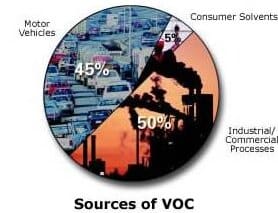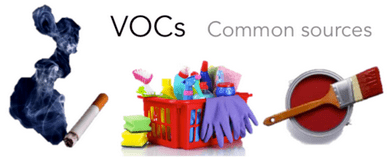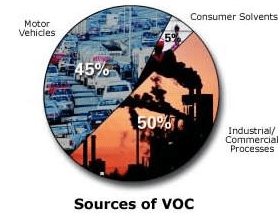What are VOCs? Anyone? Anyone? I am sure you have heard that term in some shape or form at some point in your life. Or I am sure you have at least heard of VOCs recently due to all the talk of the new proposal to cut emissions by 45% by 2025! But I am not going into that right now. You can check out some of our recent blogs for more discussion on that one. I just want to simply discuss, at its core, what VOCs are and why you should care.
VOCs stands for volatile organic compounds. The are “organic chemicals that have a high vapor pressure at ordinary room temperature. Their high vapor pressure results from a low boiling point, which causes large numbers of molecules to evaporate or sublimate from the liquid or solid form of the compound and enter the surrounding air.” (wikipedia)

VOCs can be a variety of different chemicals found in many different products. Some examples of products that emit VOCs are: pesticides, cleaning supplies, paints, wax, printers & copiers, glues, permanent markers, etc. You can see in the table above, a pie chart resembling each source that causes VOC emissions and the percentage each source makes up. Some VOCs are harmful to plants, humans, and the environment so they are regulated by law. Some health effects include; sniffly nose, asthma, nausea, eye, nose, and throat irritation.

VOCs in the Oil & Gas Industry
According to epa.gov, the oil & gas industry makes up the largest source of emission of VOCs. The EPA has estimated that the industry has emitted 2.2 million tons in the year 2008 of VOCs. The oil & gas industry has a variety of equipment and operations. This includes but is not limited to wells, gathering lines, distribution pipelines, processing facilities, and storage tanks. This equipment and operations may take part in emitting VOCs.
Cutting VOCs
So like I said at the beginning of this blog, the oil & gas industry is being looked at and being told to cut emissions, including VOCs. I agree that the industry should do what it can to cut emissions. After all, we wouldn’t want to harm the environment we live in. But take a look again at the chart above. The industry is not the only cause of VOCs. There are other ways to help cut emissions.
Of course, since I am in the oil & gas industry, I wanted to focus on how the industry can help cut these VOCs. Better yet, I wanted to focus on how CROFT can help cut VOCs. CROFT designs solutions that are environmentally friendly and provide units that have little to no emissions and VOCs. To find out more about our eco-friendly units, click the link below!
https://en.wikipedia.org/wiki/Volatile_organic_compound












